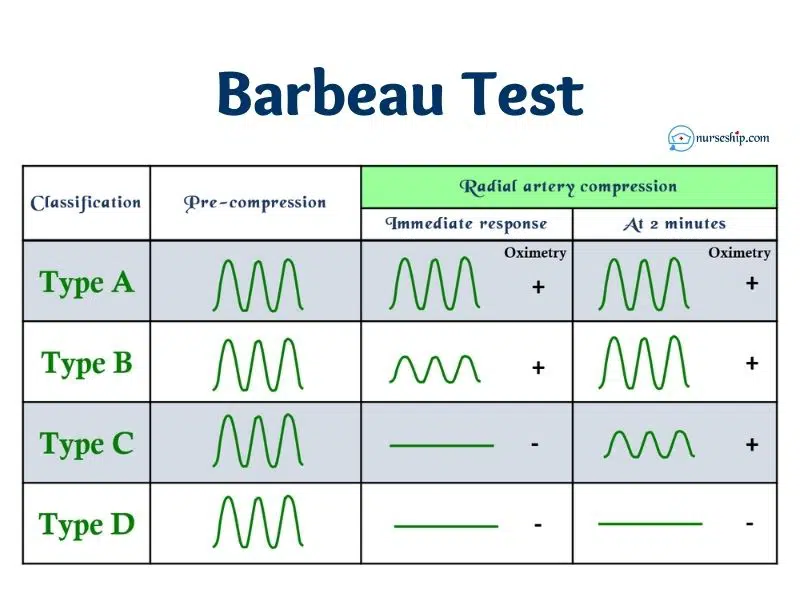Last updated on December 28th, 2023
In this post, we’ll learn about the Barbeau test and the reverse Barbeau test.
What is the Barbeau test?
The Barbeau test or Allen’s oximetry test is a modification of Allen test to assess vascular patency of the hand. Instead of observing the palm’s color, the Barbeau test analyzes plethysmography tracing.
Barbeau test can be defined as a modified version of Allen’s test using pulse oximetry and plethysmography to evaluate the collateral circulation of the ulnar artery.
According to a study, this test is more sensitive to detect the adequacy and patency of the palmar arteries, excluding only 1.5% of the patient. Hence qualifying more patients for transradial procedures.
Purpose of Barbeau test
The purpose of the Barbeau test is to assess the adequacy of collateral circulation of the ulnar artery before undergoing transradial procedures and wrist surgeries
How to perform Barbeau test
- Explain the procedure to the patient and obtain verbal consent
- Place the sensor on the thumb or index finger and note the initial plethysmography waveform and oxygen saturation on the monitor
- Next, the examiner occludes the radial and ulnar arteries simultaneously to block blood flow. It should flat line the plethysmography waveform tracing.
- Examiner then releases the pressure on the ulnar artery while keeping pressure on radial artery. Then analyzes the plethysmography tracing for 2 minutes.
Barbeau Test Classification and Interpretation
The interpretation of the Barbeau test is based on changes that appear on plethysmography tracing. These changes are classified into four types according to plethysmography tracing responses. The initial response is analyzed immediately upon releasing pressure on the ulnar artery and at 2 minutes.
Barbeau test classification is tabulated below.
| Classification | Description |
| Type A | Upon releasing pressure on the ulnar artery, the shape and amplitude of the plethysmography tracing becomes normal immediately |
| Type B | Pulse waveform temporarily reduces the amplitude and returns to normal amplitude within 2 minutes. |
| Type C | Immediately shows a flat line and slowly waveform returns at 2 minutes. But the amplitude is dampened. |
| Type D | Shows a flat line on plethysmography tracing throughout 2 minutes. Which indicates inadequate ulnar artery circulation. |

If the responses are either type A, B, and C demonstrate the patency of the ulnar artery. Which ulnar artery alone is adequate to perfuse the hand. Hence, that hand is eligible to undergo transradial procedures such as radial artery cannulation and cardiac catheterization.
However, patients with type D responses should avoid transtradial procedures on that wrist due to inadequate ulnar collateral flow. Also, they are at high risk of ischemia in event of radial artery complications.
Reverse Barbeau Test
Like reverse Allen’s test is performed in the same manner as Allen test, reverse Barbeau test is also performed in the same manner as Barbeau test.
The only difference is this time you release the pressure on the radial artery instead of the ulnar artery. Hence, the purpose of the reverse Barbeau test is to evaluate the patency of the radial artery to perfuse the hand in the event of injury or damage to the ulnar artery.
How to perform Reverse Barbeau Test
- Step 1 to 3 are the same as the Barbeau test.
- In the 4th step, you release the pressure on the radial artery instead of the ulnar artery. Then observe the plethysmography tracing for 2 minutes.
- Also, the interpretation of findings is the same as the Barbeau test.
Barbeau test vs Allen test
Barbeau test is one of the modified and more quantitative versions of the Allen test which uses pulse oximetry and plethysmography.
On the other hand, Allen test is the original method which employs a more qualitative approach to evaluate collateral blood circulation to the hand.
The similarities and differences of the Barbeau test and the Allen test are tabulated below.
| Allen test | Barbeau test | |
| Description | – Original method of assessing collateral blood circulation to hand. – Observes palmar color changes | – Modified version of Allen test. – Uses pulse oximetry and plethysmography tracing |
| Purpose | – To assess the collateral circulation of the arteries of the hand. – Allen test asses ulnar artery’s patency – Reverse Allen test assesses radial artery’s patency | – To assess the collateral circulation of the arteries of the hand. – Barbeau test assesses ulnar artery’s patency – Reverse Barbeau test assesses radial artery’s patency |
| Technique | Observes time taken to return hand’s normal color after releasing the releasing pressure off the artery | Analyzes plethysmography tracing for 2 minutes after releasing pressure off the artery |
| Interpretation | – If the hand’s color returns to normal pinkish color within 5-15 seconds →Positive Allen test (i.e., ulnar artery’s collateral circulation is adequate) – If the hand’s color does not return to normal pinkish color after 15 seconds →Negative Allen test (i.e., ulnar artery’s collateral circulation is inadequate) | – Responses of plethysmography tracing is classified into 4 types; either A, B, C, or D.- A is normal – In case of B and C, the artery can be used for transradial procedures- In case of D, transradial procedure should be avoided on that wrist |
Conclusion
To sum up, the Barbeau test is modified Allen test with pulse oximeter and plethysmography performed to check patency of the ulnar artery. And the reverse Barbeau test assesses the patency of the radial artery.
The findings of the test are classified into either A, B, C, or D. Categories A, B, or C means patient can undergo transradial procedures on that hand. And ulnar artery’s collateral circulation is adequate to prevent that hand’s ischemia in case of an adverse event followed by the transradial procedure or wrist surgeries.
In contrast, if the result is D, transradial procedure should be avoided on that wrist.
CLICK HERE to learn the purpose and technique of the Allen test.
Reference
Abu-Fadel, M. (2016). Arterial and Venous Access in the Cardiac Catheterization Lab. United States: Rutgers University Press.
Advanced Practice and Leadership in Radiology Nursing. (2019). Springer International Publishing.
Bhatt, D. L. (2015). Cardiovascular Intervention: A Companion to Braunwald’s Heart Disease, E-Book. Elsevier Health Sciences.
Interventional Radiology: Fundamentals of Clinical Practice. (2019). Oxford University Press.
Kern, M. J. (2015). Cardiac Catheterization Handbook. United Kingdom: Elsevier.
Practical Manual of Interventional Cardiology. (2021). Germany: Springer International Publishing.
Transradial Angiography and Intervention: An Issue of Interventional Cardiology Clinics, E-Book. (2019). Netherlands: Elsevier Health Sciences.
Yoshimachi, F. (2020). Slender PCI: Extremely Minimally Invasive Percutaneous Coronary Intervention. Germany: Springer Singapore.




Comments are closed.